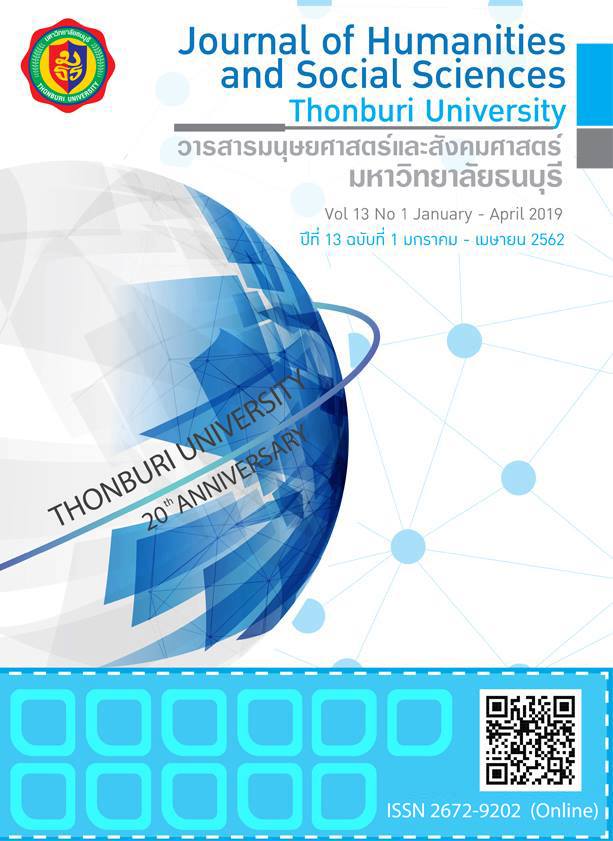MANAGING COMPETITIVE ADVANTAGES OF THAI AIR ASIA
Keywords:
Competitive Management, Low Cost Airline, Thai Air AsiaAbstract
Abstract
The research entitled “Managing Competitive Advantages of Thai Air Asia” aims to 1) to study the characteristics of competitiveness management of Thai Air Asia, 2) to identify competitive advantages of Thai Air Asia in low cost airline industry, 3) to study and analyze how Thai Air Asia maintains its top position in Thailand’s low cost airline industry. This study is qualitative research of depth interviews which key informants including 9 personnel in Thai Air Asia such as CEOs, management team, and operational officers, and 10 other informants who are actively involved in airline business and others.
The results of study indicated that Thai Air Asia are being selective in its competitive strategic management, diversifying it into the dimension of Management Innovation and Innovation Management dimension, Total Quality Management dimension, Leadership Dimension, Organizational Culture dimension, and Employee Engagement dimension. Thai Air Asia’s “Core Competency” lies mostly in its cost efficient management, the factor differentiating Thai Air Asia’s competitiveness with those of others in the low cost airline industry. These include an innovation management of the holding company and always maintain its low-cost structure. Moreover, there are efficient procedures of selecting appropriate type of staff members, cultivating an attitude, and creating strongly organization culture. Also use the dynamic pricing strategy which made Thai Air Asia become the leader of low cost airline efficiently and sustainably.
Keywords: Competitive Management, Low Cost Airline, Thai Air Asia
References
ตลาดหลักทรัพย์แห่งประเทศไทย. (2560). บริษัทเอเชียเอวิเอชั่นจำกัด(มหาชน). สืบค้นเมื่อ มิถุนายน 2560, จาก http://www. set.or.th/set/companyhighlight.do?symbol=AAV&language=th&country=TH
ธรรศพลฐ์ แบเลเว็ลด์. (2560). ประธานกรรมการบริหาร. สายการบินไทยแอร์เอเชีย. (2560, พฤศจิกายน 15). สัมภาษณ์.
นิศา ชูโต. (2551). การวิจัยเชิงคุณภาพ. กรุงเทพฯ: พี.เอ็น. การพิมพ์.
บริษัท ท่าอากาศยานไทย จำกัด. (2560). รายงานสถิติการขนส่งทางอากาศปี 2552-2559. สืบค้นเมื่อ มิถุนายน 2560, จากhttp://www.aot-th.listedcompany.com/transport.html.
พงษ์ศักดิ์ เสริมพงษ์พันธ์. (2553). นวัตกรรมกับการจัดการเชิงกลยุทธ์. วารสารวิชาการมหาวิทยาลัยธนบุรี. 4(8).
สุภางค์ จันทวานิช. (2549). วิธีการวิจัยเชิงคุณภาพ. กรุงเทพฯ: สำนักพิมพ์จุฬาลงกรณ์มหาวิทยาลัย.
Buchanan, B. (1974). Building Organizational Commitment: The Socialization of Managers in Work Organizations. Administrative Science Quarterly.
Cross, Robert G. (1995). An Introduction to Revenue Management. In Handbook of Airline Economics, New York.
Denison, Daniel R. (1990). Corporate Culture and Organization Effectiveness. New York: John Wiley & Son.
Denizen, N.K. (1970).The Research Act: The Theoretical Introduction to Sociological Methods. Chicago: Aldine.
Evans, J.R.;& Lindsay, W.M. (1999). The Management and Control of Quality. Cincinnati,OH: South-Western College.
Fiedler, Fred E. (1967). A Theory of Leadership Effectiveness. New York: McGraw-Hill.
Gibbons, A. (1997). Innovation and the Developing of Knowledge Production, University of Sussex, London.
Hamel, Gary. (2006). The Future of Management. Harvard Business School, 2007 Press.
House, Robert J., and Mitchell, T.R. (1974). Path-Goal Theory of Leadership. Journal of Contemporary Business.
Juran, J. M. (1989). Juran on Quality by Design: The New Steps for Planning Quality into Goods and Service. New York: Juran.
Kim, W.C. and Mauborgne, R. (2005). Blue Ocean Strategy: From Theory to Practice. California. Management Review.
Patton, M.Q. (1990). Qualitative Evaluation and Research Metho. 2nded. California: Sage.
Porter, M. (1990). The Competitive Advantage of Nations. London: The Free Press.
Translated Thai References
Airport of Thailand Plc. (2017). Air Transport Statistic Report year 2009-2016. Retrieved June 2017, from http://www.aot-th.listedcompany.com/transport.html. (in Thai)
Belevelle, T. (2017). CEO Thai Air Asia. (2017, November 15). Interview. (in Thai)
Chantawanich. (1995). Quality Research Method. Bangkok: Chulalongkorn University Publishing. (in Thai)
Chootoh, N. (1997). Qualitative Research. Bangkok: P.N. Printing. (in Thai)
Seangsrijirapat, K. Thai Air Asia Passenger. (2017, October 30). Interview. (in Thai)
Sermpongpun, P. (2010). Innovation and Strategy Management. Journal of Thonburi University. 4(8). (in Thai)
The Stock Exchange of Thailand. (2017). Asia Aviation Public Company Limited. Retrieved June 2017, from http:// www.set.or.th/set/companyhighlight.do?symbol=AAV&language=th&country=TH (in Thai)







